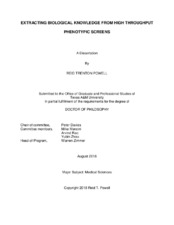| dc.description.abstract | High throughput drug screening has greatly progressed drug discovery for diseases such as cancer. Specifically, the introduction of the automated microscope in high throughput drug screening has facilitated the acquisition of very large amounts of phenotypic data of how biological systems respond to drugs. Indeed, phenotypic analysis has become preferential over traditional biochemical methods due to the ability to measure multiple factors simultaneously, making it a highly efficient method to establish drug sensitivity data. However, these methods heavily rely on the ability to reliably extract quantitative metrics describing alterations in phenotypes in order to begin to approach this data format and make decisions about how populations of cells are responding to perturbagens. A major contribution of this research has been the establishment of a paradigm aimed at translating raw HTS data from phenotypic screens into functional knowledge about biological systems. Importantly, this paradigm starts at the evaluation of the biological question, which dictates the model system, influences the method of data acquisition and processing, and level of statistical analysis. Furthermore, the newly generated information must then be integrated with pre-existing knowledge to facilitate extraction of the new knowledge about the biological process being studied. I have applied this paradigm to multiple biological studies including: the identification a novel class of drug that targets SKP2 mediated degradation of p27 via interference of a protein-protein interaction, the discovery of bexarotene as a novel regulator of cellular primary cilia, and profiling the pharmacologic susceptibilities of panels of cells lines. Each of these projects have contributed new knowledge to their respective fields, however, they also serve as examples of generalizable screening pipelines and methods that can be applied to additional studies. While these applications have had specific emphasis on understanding the interactions of drugs on cancer cells, the image processing tools and methodological approaches developed here are generalizable to application in other fields including histology, toxicology, and microbiology. | en |


